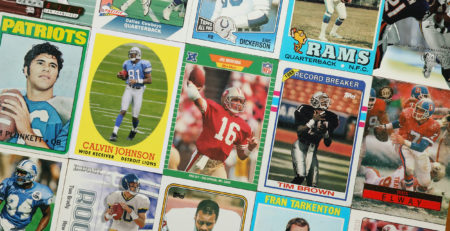A Brief History of Sports Trading Cards
All of us here have a passion for the hobby, but how many of us know where our beloved hobby came from? The landscape of the trading card industry has changed dramatically over the decades since its inception, and we expect it to continue to change as collector appetites evolve. But to understand where we are today, we need to understand how we got here…
Baseball cards started to be printed in the 1860’s soon after baseball became a professional sport. However, their popularity is owed to the tobacco and other industries who chose to use these cards are prizes. If it weren’t for their use as a marketing tool, the hobby we know and love today may not be here.
Baseball cards – or any other sport – actually weren’t the first trading cards. That designation actually belongs to what was called a “trade card”. One of the very first known examples of these were found in packs of cigarettes. A trade card would help advertise the product, and it would be tucked away in the paper packaging to help stiffen the package and protect the product. Allen and Ginter was the first tobacco company to print advertisements in the U.S., and over the following years this practice continued to grow. These trade cards would showcase a variety of topics – targeting men who smoked – such as nature, war, and of course, sports.
By the turn of the century in 1900, thousands of sets of trade cards manufactured by hundreds of tobacco companies started to flood the market. Children would even wait outside retail stores, and when a customer who just bought a new pack of cigarettes would walk out, the children would ask for the card. A collectors hobby was born. However, during World War II, the practice of printing paper advertisements like trade cards came to a halt due to paper shortages, and the practice never really made a comeback within the tobacco industry. But the concept of prizes such as cards within retail products stuck around, and now various trade cards could be found in the packaging of multiple types of products.
In the early 1900’s, most baseball cards came in either candy or tobacco products. It was during this timeframe that the most valuable card in history was manufactured – the T206 Honus Wagner tobacco card. Less than 200 of these cards were ever produced, and the value has skyrocketed into the millions over the years and is easily one of the most valuable sports cards today.
Baseball cards continued to evolve over the following decades. In the 1930’s, manufacturers began to print biographies on the back of the the cards. Baseball cards were now also found in packs of bubble gum, and as many of us fondly remember, this eventually flipped and turned into putting bubble gum in packs of baseball cards.
What many people may not realize is that Topps – one of the largest players in the sports trading card industry – didn’t actually start as a trading card company. The company actually started as Topps Chewing Gum, Inc., and they began inserting trade cards into their packaging in 1950. These cards depicted TV and film stars, big game hunters, and American football players. Topps produced their first baseball card in 1951, and the first true sports trading card as we see them today was created in 1952. These cards included player records, statistics and biographies, and it became one of the most popular and valuable sets of all time. For example, this set contains the rookie card for Mickey Mantle. This was the birth of the modern sports trading card.
Production of sports trading cards took of from there, and while baseball held onto its place as the most popular for years, other sports began to become involved. Today, there are trading cards for every major sport, as well as a variety of others – baseball, football, basketball, hockey, golf, racing, etc. The value of the cards is heavily dependent on a few factors such as age and condition, as well as availability.
Especially in the 1980’s and 1990’s, manufacturing of sports trading cards boomed. The market became flooded with trading cards, and this is a big reason why many cards from that era don’t hold the value you’d expect. Manufacturers learned their lesson, however, and since then the volume of cards produced is more carefully controlled. Today, as we all know, the value of individual trading cards has skyrocketed to the point where some hobby boxes are in fact just one or two single packs containing only a few cards each.
Decades ago, collectors were constantly trying to complete a full set. Today, however, their is very little focus on complete sets and more energy is put toward finding the most valuable individual cards.
The sports trading card hobby has a long and interesting history, and as collectors, we owe thanks to the other industries such as tobacco and candy/chewing gum manufacturers that helped create our beloved hobby. And moving forward, it will be interesting to see how our industry continues to evolve.



Leave a Reply